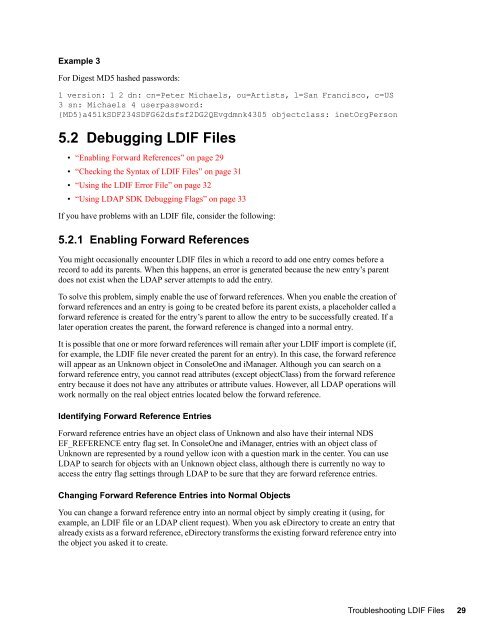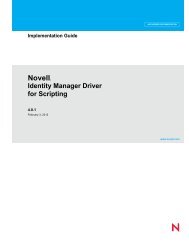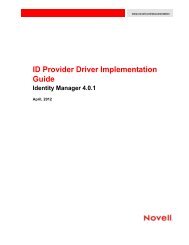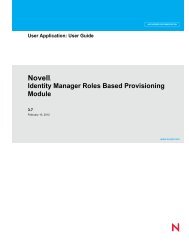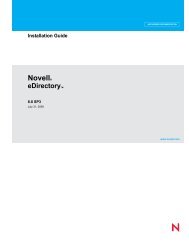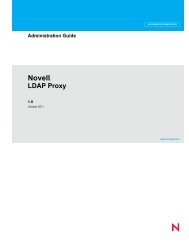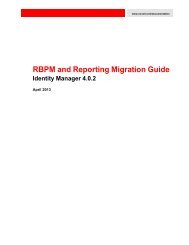Novell eDirectory 8.8 Troubleshooting Guide - NetIQ
Novell eDirectory 8.8 Troubleshooting Guide - NetIQ
Novell eDirectory 8.8 Troubleshooting Guide - NetIQ
Create successful ePaper yourself
Turn your PDF publications into a flip-book with our unique Google optimized e-Paper software.
Example 3<br />
For Digest MD5 hashed passwords:<br />
1 version: 1 2 dn: cn=Peter Michaels, ou=Artists, l=San Francisco, c=US<br />
3 sn: Michaels 4 userpassword:<br />
{MD5}a45lkSDF234SDFG62dsfsf2DG2QEvgdmnk4305 objectclass: inetOrgPerson<br />
5.2 Debugging LDIF Files<br />
• “Enabling Forward References” on page 29<br />
• “Checking the Syntax of LDIF Files” on page 31<br />
• “Using the LDIF Error File” on page 32<br />
• “Using LDAP SDK Debugging Flags” on page 33<br />
novdocx (ENU) 01 February 2006<br />
If you have problems with an LDIF file, consider the following:<br />
5.2.1 Enabling Forward References<br />
You might occasionally encounter LDIF files in which a record to add one entry comes before a<br />
record to add its parents. When this happens, an error is generated because the new entry’s parent<br />
does not exist when the LDAP server attempts to add the entry.<br />
To solve this problem, simply enable the use of forward references. When you enable the creation of<br />
forward references and an entry is going to be created before its parent exists, a placeholder called a<br />
forward reference is created for the entry’s parent to allow the entry to be successfully created. If a<br />
later operation creates the parent, the forward reference is changed into a normal entry.<br />
It is possible that one or more forward references will remain after your LDIF import is complete (if,<br />
for example, the LDIF file never created the parent for an entry). In this case, the forward reference<br />
will appear as an Unknown object in ConsoleOne and iManager. Although you can search on a<br />
forward reference entry, you cannot read attributes (except objectClass) from the forward reference<br />
entry because it does not have any attributes or attribute values. However, all LDAP operations will<br />
work normally on the real object entries located below the forward reference.<br />
Identifying Forward Reference Entries<br />
Forward reference entries have an object class of Unknown and also have their internal NDS<br />
EF_REFERENCE entry flag set. In ConsoleOne and iManager, entries with an object class of<br />
Unknown are represented by a round yellow icon with a question mark in the center. You can use<br />
LDAP to search for objects with an Unknown object class, although there is currently no way to<br />
access the entry flag settings through LDAP to be sure that they are forward reference entries.<br />
Changing Forward Reference Entries into Normal Objects<br />
You can change a forward reference entry into an normal object by simply creating it (using, for<br />
example, an LDIF file or an LDAP client request). When you ask <strong>eDirectory</strong> to create an entry that<br />
already exists as a forward reference, <strong>eDirectory</strong> transforms the existing forward reference entry into<br />
the object you asked it to create.<br />
<strong>Troubleshooting</strong> LDIF Files 29


